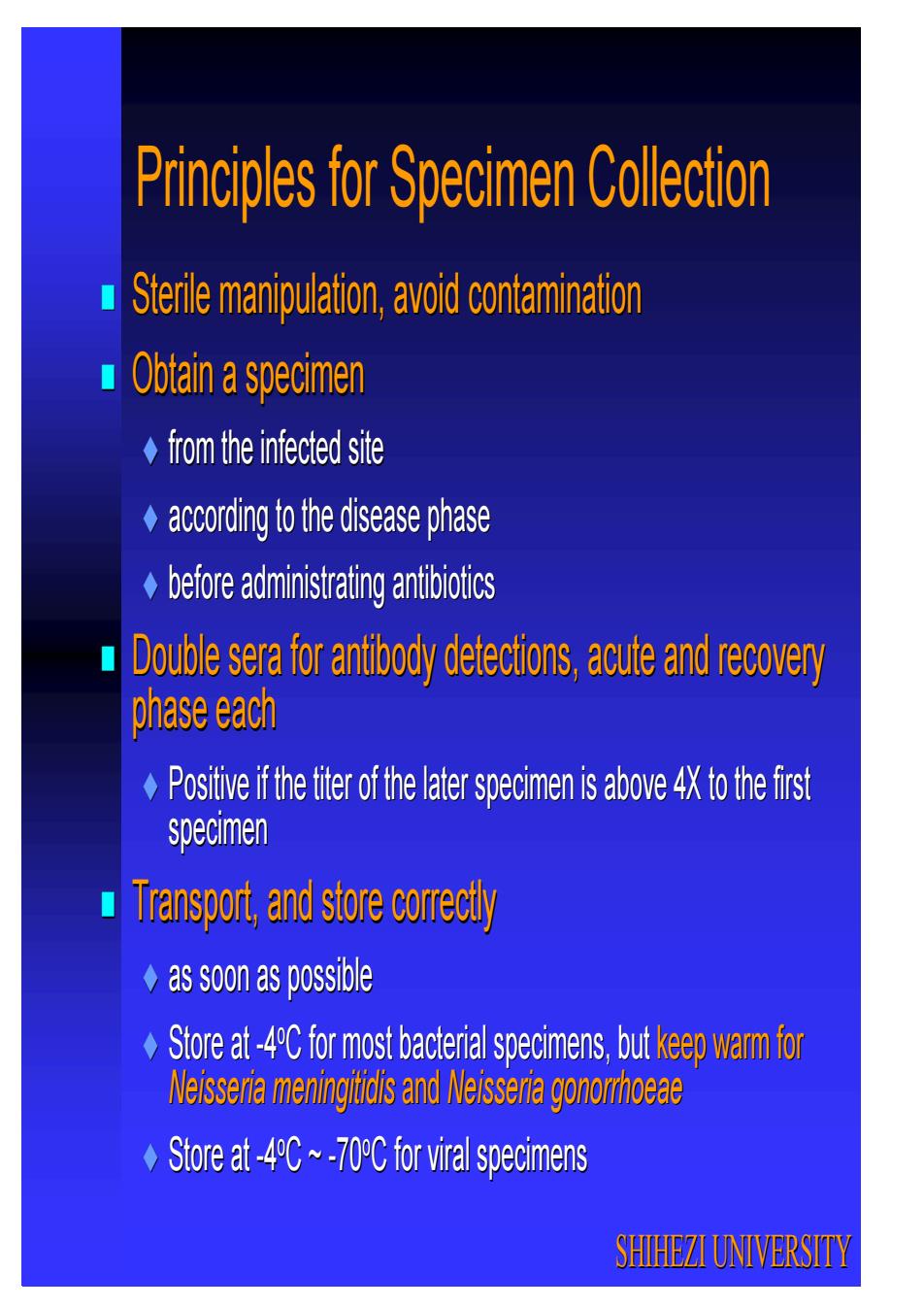
Principles for Specimen CollectionSterilemanipulation,avoid contamination Obtain a specimen+from the infected siteaccording tothedisease phase+beforeadministrating antibioticsDouble sera for antibody detections, acute and recoveryphase eachPositiveif thetiterofthelaterspecimen isabove4XtothefirstspecimenTransport,and storecorrectly+ as soon as possibleStoreat-4CformostbacterialspecimensbutkeepwarmforNeisseria meningitidis and Neisseria gonorrhoeaeStore at -4~-70°C for viral specimensSHIHEZIUNIVERSITY
Principles for Specimen Collection Sterile manipulation, avoid contamination Sterile manipulation, avoid contamination Obtain a specimen Obtain a specimen from the infected site from the infected site according to the disease phase according to the disease phase before administrating antibiotics before administrating antibiotics Double sera for antibody detections, acute and recovery Double sera for antibody detections, acute and recovery phase each phase each Positive if the titer of the later specimen is above 4X to the f Positive if the titer of the later specimen is above 4X to the first irst specimen specimen Transport, and store correctly Transport, and store correctly as soon as possible as soon as possible Store at Store at -44oC for most bacterial specimens, but C for most bacterial specimens, but keep warm for keep warm for Neisseria Neisseria meningitidis meningitidis and and Neisseria Neisseria gonorrhoeae gonorrhoeae Store at Store at -44oC ~ C ~ -7070oC for viral specimens C for viral specimens SHIHEZI UNIVERSITY
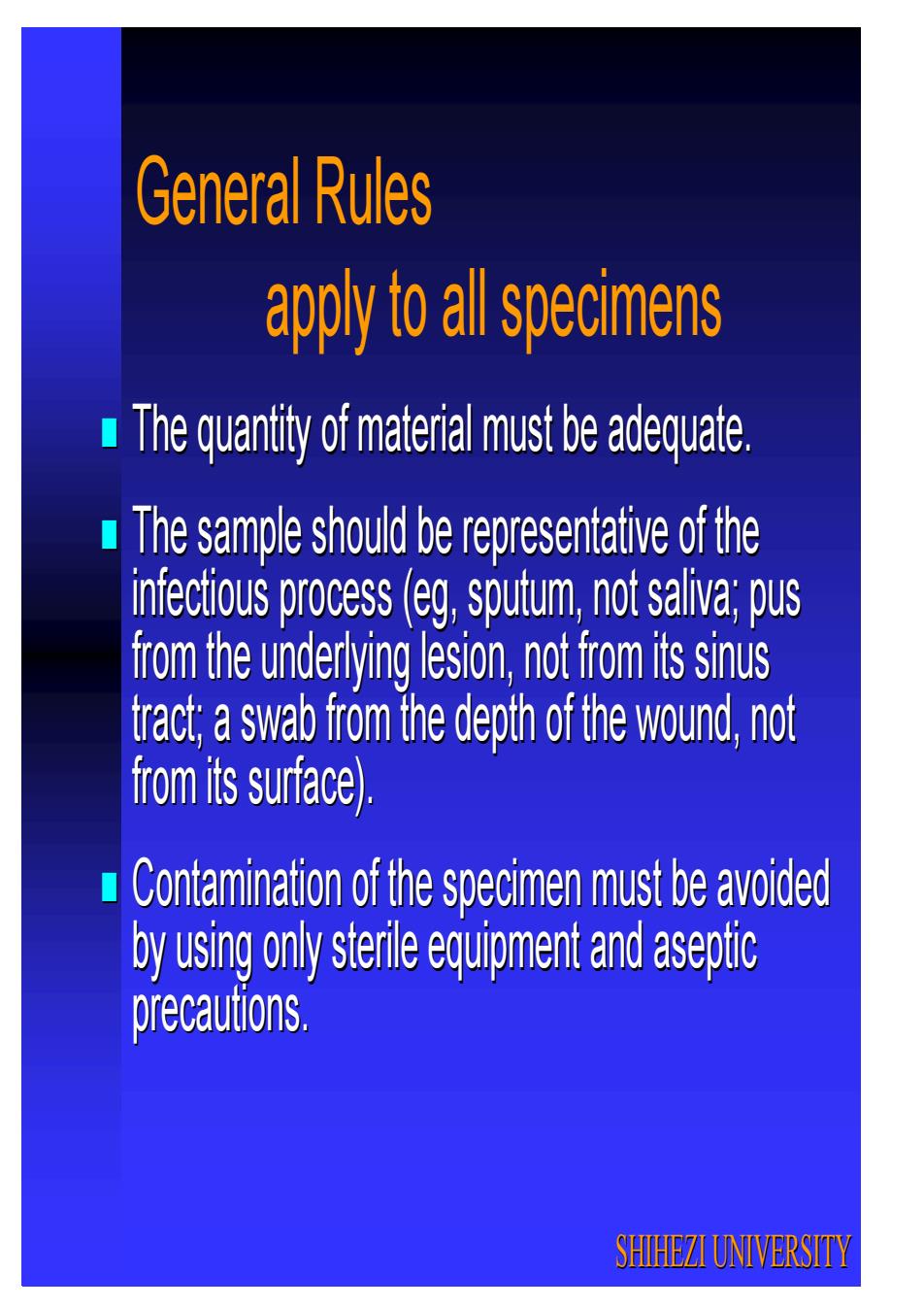
General Rulesapply to all specimensThe quantity of material must be adequateThe sample should be representative of theinfectious process (eg, sputum, not saliva; pusfrom the underlying lesion, not from its sinustract; a swab from the depth of the wound, notfrom its surface) Contamination of the specimen must be avoidedby using only sterle equipment and asepticprecautions.SHIHEZIUNIVERSITY
General Rules apply to all specimens The quantity of material must be adequate. The quantity of material must be adequate. The sample should be representative of the The sample should be representative of the infectious process ( infectious process (egeg, sputum, not saliva; pus , sputum, not saliva; pus from the underlying lesion, not from its sinus from the underlying lesion, not from its sinus tract; a swab from the depth of the wound, not tract; a swab from the depth of the wound, not from its surface). from its surface). Contamination of the specimen must be avoided Contamination of the specimen must be avoided by using only sterile equipment and aseptic by using only sterile equipment and aseptic precautions. precautions. SHIHEZI UNIVERSITY
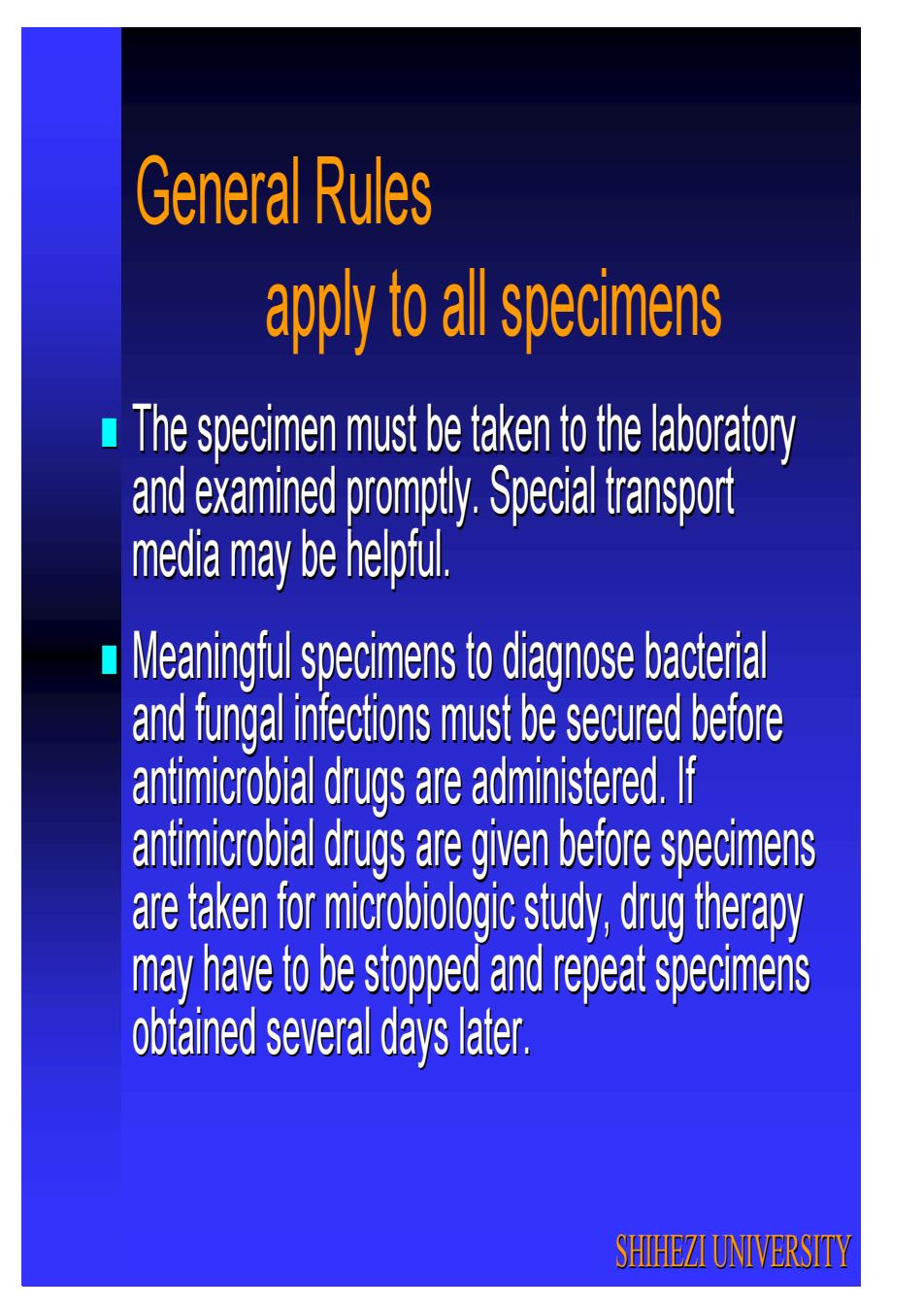
General Rulesapply to all specimens The specimen must be taken to the laboratoryand examined promptly. Special transportmedia may be helpfulMeaningful specimens to diagnose bacteriaand fungal infections must be secured beforeantimicrobial drugs are administered. Ifantimicrobial drugs are given before specimensare taken for microbiologic study, drug therapymay have to be stopped and repeat specimensobtained several days laterSHIHEZIUNIVERSITY
General Rules apply to all specimens The specimen must be taken to the laboratory The specimen must be taken to the laboratory and examined promptly. Special transport and examined promptly. Special transport media may be helpful. media may be helpful. Meaningful specimens to diagnose bacterial Meaningful specimens to diagnose bacterial and fungal infections must be secured before and fungal infections must be secured before antimicrobial drugs are administered. If antimicrobial drugs are administered. If antimicrobial drugs are given before specimens antimicrobial drugs are given before specimens are taken for microbiologic study, drug therapy are taken for microbiologic study, drug therapy may have to be stopped and repeat specimens may have to be stopped and repeat specimens obtained several days later. obtained several days later. SHIHEZI UNIVERSITY
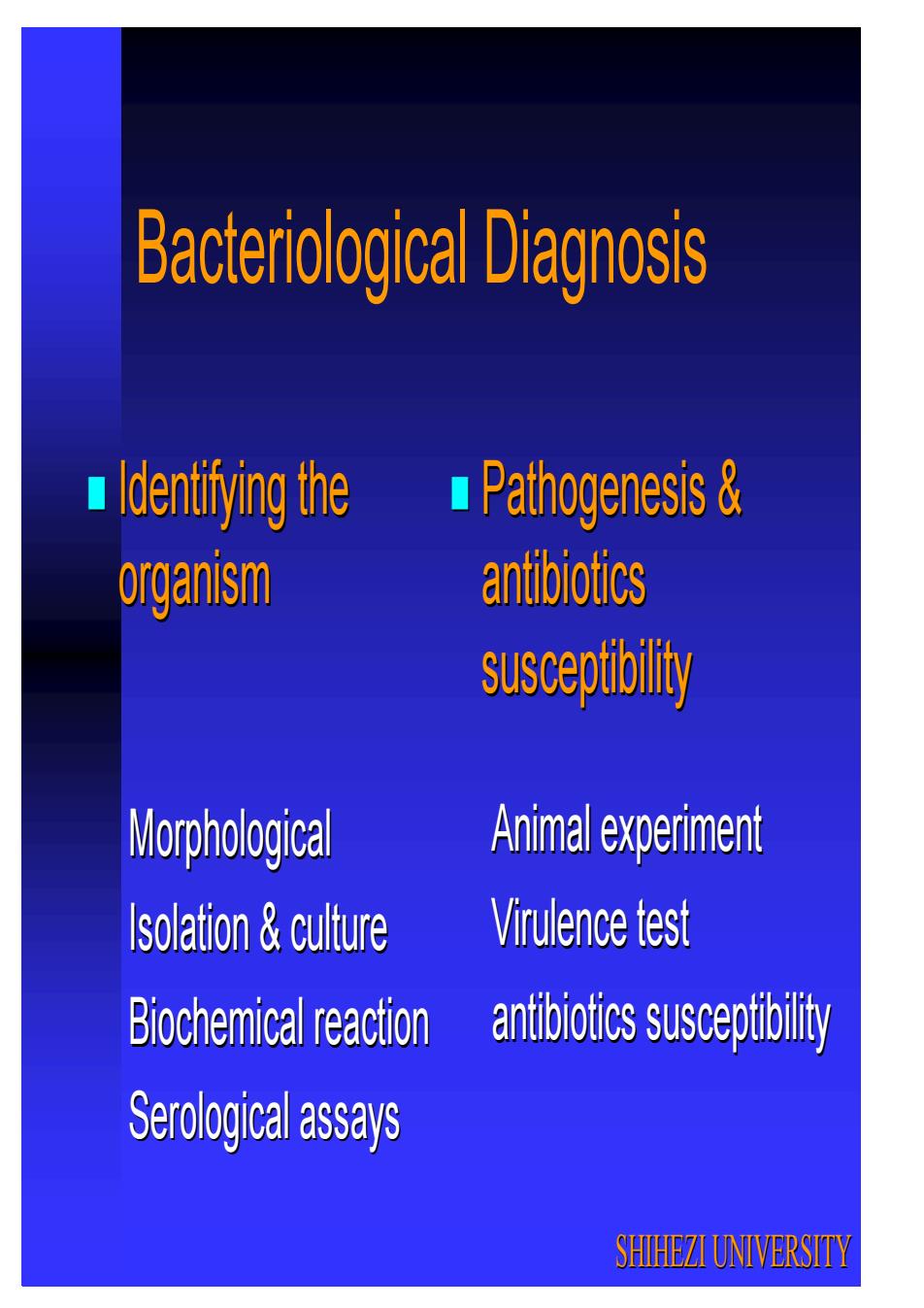
Bacteriological Diagnosis Identifying the Pathogenesis &antibioticsorganismsusceptilityAnimal experimentMorphologicalVirulence testIsolation &cultureantibiotics susceptibilityBiochemical reactionSerological assaysSHIHEZI UNIVERSIT
Bacteriological Diagnosis Identifying the Identifying the organism organism Morphological Morphological Isolation & culture Isolation & culture Biochemical reaction Biochemical reaction Serological assays Serological assays Pathogenesis & Pathogenesis & antibiotics antibiotics susceptibility susceptibility Animal experiment Animal experiment Virulence test Virulence test antibiotics susceptibility antibiotics susceptibility SHIHEZI UNIVERSITY
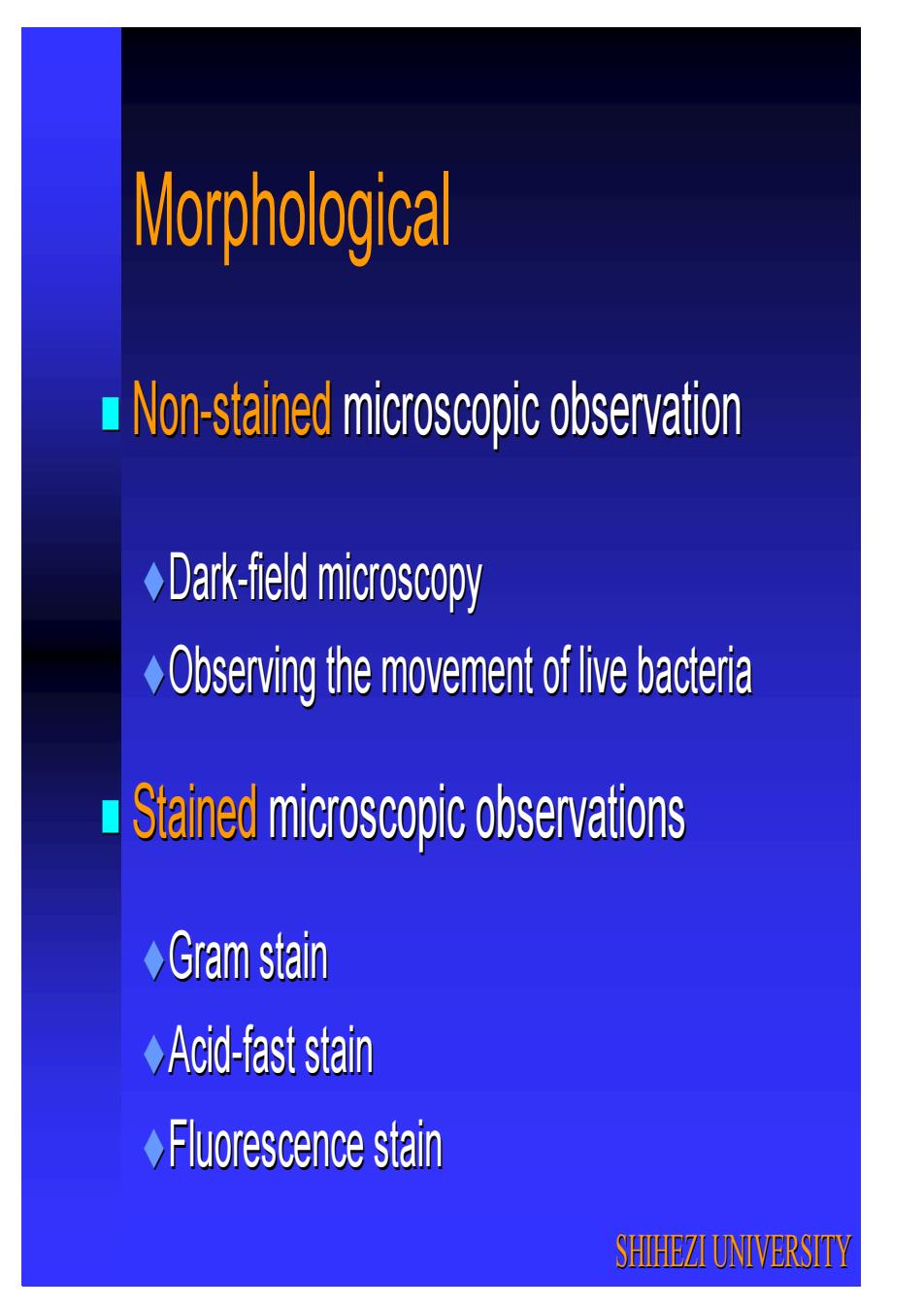
MorphologicalNon-stained microscopic observationDark-field microscopyObserving the movement of live bacteria Stained microscopic observationsGram stainAcid-fast stainFluorescence stainSHIHEZIUNIVERSITY
Morphological Non Non-stained stained microscopic observation microscopic observation Dark Dark-field microscopy field microscopy Observing the movement of live bacteria Observing the movement of live bacteria Stained Stained microscopic observations microscopic observations Gram stain Gram stain Acid Acid-fast stain fast stain Fluorescence stain Fluorescence stain SHIHEZI UNIVERSITY